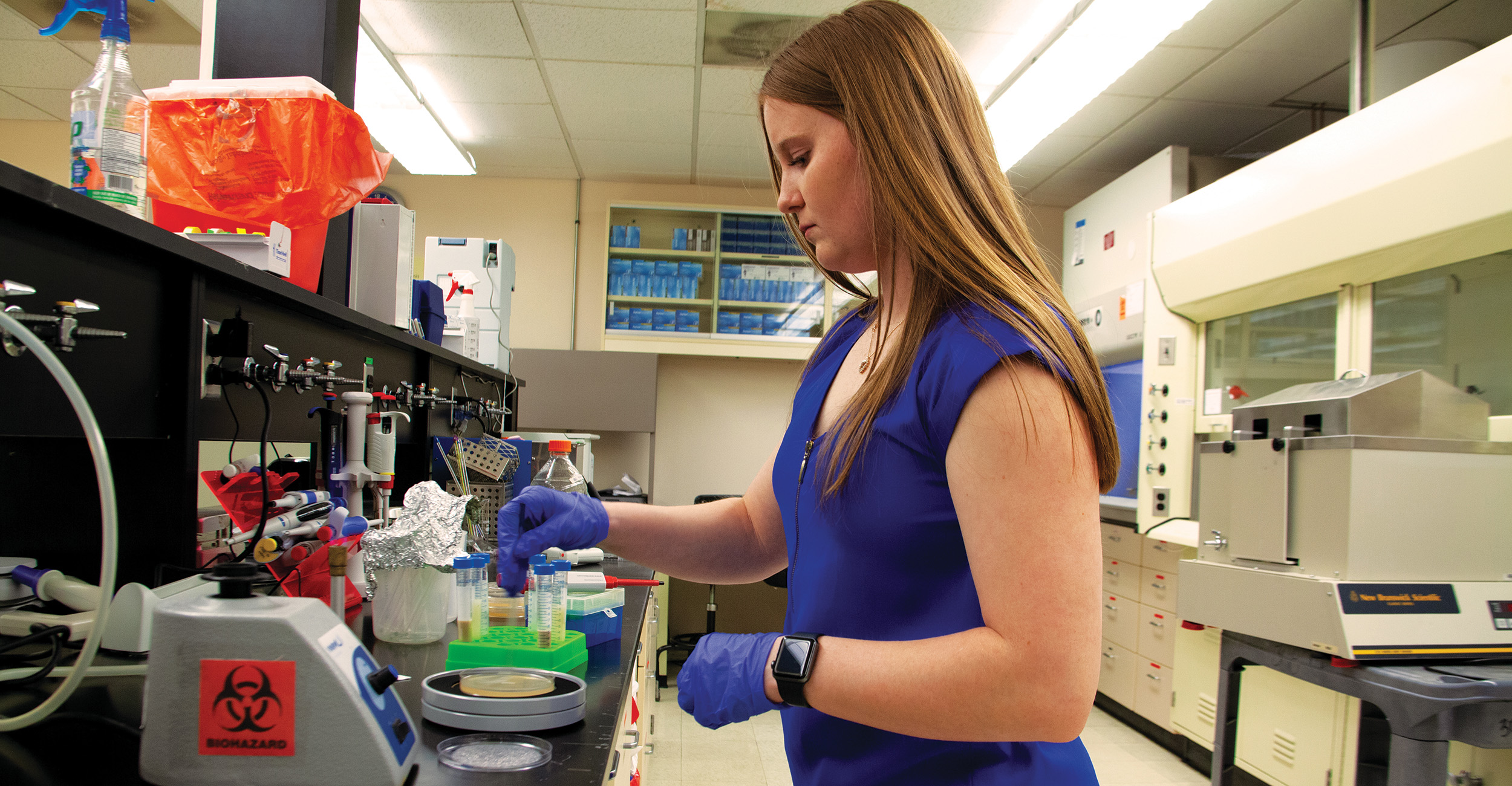
Progress With Probiotics
Friday, May 27, 2022
Media Contact: Jami Mattox | Agricultural Communications Services | 405-744-8061 | jami.mattox@okstate.edu
Yogurt, kombucha and sauerkraut — these products may seem very different, but they have something in common — they contain probiotics.
In recent years, the use of probiotics has increased in the United States as consumers choose it for health and beauty reasons, said Jessie Payne, food science doctoral student at Oklahoma State University.
Payne is conducting research that may lead to probiotics being in a more diverse range of food products in the future, she said.
“I wanted to learn a little bit of everything,” she said. “That’s how I knew this research was going to be great for me because it consists of multiple studies all within one big project.”
The research tests the water activity and baking conditions of probiotics as well as the effectiveness of probiotics against Listeria monocytogenes in ready-to-eat hummus. Payne’s two project advisers applied for a grant for the project to gain more funding for the studies, Payne said.
“We are hoping to learn that when you use probiotic spores, the benefit associated with them could be extended to help protect food from food-borne pathogens,” said Ravi Jadeja, animal and food science associate professor and food safety specialist who is one of the project’s three faculty directors. “Overall, we hope to learn if adding spores into food products will be able to provide any safety benefits.”
The project, titled “Evaluation of Stability and Increased Functionality of Several Bacillus Strains with Probiotic Properties,” began in September 2021 with testing the water activity and baking condition of Bacillus subtilis, one of the chosen probiotics for this project, Payne said.
“Step one is determining if this strain of probiotics can survive in different baking conditions and whether they are affected by water activity,” Payne said. “We took 0.091 grams of the probiotic and baked them to 450°F along with testing the probiotic in different water activity levels and compared them to their controls, which were unmodified.”
By testing these conditions on the Bacillus subtilis probiotic, the researchers discovered this probiotic can withstand temperatures up to 450°F as well as various levels of water activity. These results were surprising because most probiotics cannot withstand such high temperatures.
With these results, the American food industry may be able to create baked goods with a probiotic additive, Payne said.
“Utilizing probiotics in baked goods allows consumers to diversify the way they manage their gut health with an expansion in product options,” said Corrine Burrus, undergraduate research assistant and food science senior. “This now goes beyond your typical yogurt and probiotic drinks.”
Challenges during the first part of this project arose while plating the probiotics to gather results. Activation of the probiotic first via heat shock was the best way to continue in the plating process, said Danielle Bellmer, professor in the OSU Department of Biosystems and Agricultural Engineering and adviser for Payne.
“One main struggle we have faced so far was figuring out how to get the probiotic to grow on a plate,” Payne said. “The probiotics can be very finnicky because they are in spore form, and spores have to have a very specific environment in order to germinate.”
Payne discovered the pour plate method worked best, she said. This method consists of placing the probiotic solution on the plate then mixing it with tryptic soy agar to solidify it.
In contrast, the common spread plate method involves spreading the solution on top of the already gelled media, Payne said.
The first part of this project provided positive results and the second part of the project started in February, Payne said.
In the second part of this project, being able to see probiotics inhibit the growth of Listeria monocytogenes in ready-to-eat dips could be huge for food safety in refrigerated products, Bellmer said.
“The current study consists of testing the probiotic mixed with Listeria in ready-to-eat hummus to determine if the probiotics will inhibit the Listeria growth,” Payne said.
The importance of this research is to impact people’s lives, Jadeja said. This project provides multiple avenues for expansion in food safety and the production of more foods with the health benefits of probiotics, he added.
“This is definitely going to be welcomed news if this research goes in the direction we intend,” Jadeja said. “Food safety is a big concern for everyone. In the U.S. alone, 48 million people get sick with a food-borne illness yearly, and about 3,000 die. Any reduction of these illnesses would benefit society.”
The research on the effect of probiotics on Listeria may take months, but hope exists for a brighter future for food safety, Payne said.
“Using probiotics to help combat Listeria can give Americans confidence to consume a safer product with a clean label,” Burrus said. “If these probiotics will be able to be used in baked goods, consumers have an additional option to introduce beneficial bacteria into their bodies. Consumers and food production businesses gain from this research.”
Story By: Brandy DeVous | Cowboy Journal
